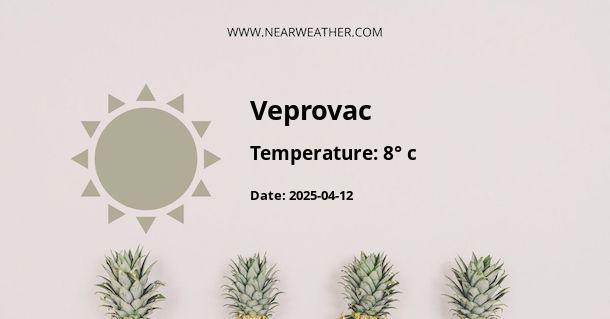Introduction to Veprovac, RS: Location and General Climate
Veprovac is a place that may not be known to everyone, but for those interested in understanding the nuances of local climates and how they impact daily life, it provides a fascinating case study. Located in the Republic of Srpska, an entity of Bosnia and Herzegovina, Veprovac experiences a continental climate, with some variations due to its geographical nuances. Situated in the Balkans, this area is subject to diverse atmospheric influences, including Mediterranean currents from the south and continental air masses from the north and northeast.
Seasonal Climate Characteristics
The climate in Veprovac is characterized by four distinct seasons—spring, summer, autumn, and winter—each with its unique weather patterns and implications for the local population and agriculture.
Spring
Spring in Veprovac typically sees an upward trend in temperatures with a noticeable reduction in snowfall and frost as the season progresses. March can still be quite chilly, with occasional snowfall, but by May, the weather typically becomes milder and more favorable for outdoor activities. This period is also marked by increased precipitation, which contributes to the lush greenery of the area.
Summer
- June to August: These months experience warm to hot temperatures, with occasional heat waves due to the influence of subtropical air masses. The average high temperatures can climb over 25°C (77°F).
- Precipitation: Despite the warm temperatures, these months can also exhibit notable precipitation, often in the form of thunderstorms that can be both intense and sudden.
- Humidity: Humidity levels generally range from moderate to high, depending on rainfall and temperature.
Autumn
The weather in autumn becomes increasingly unpredictable as the season progresses. September may still offer warm and pleasant days, akin to a late summer, but by November, temperatures drop significantly, and the chance of frost, fog, and overcast skies becomes more common. Precipitation is also a common autumn characteristic, occasionally leading to heavy rains.
Winter
- Cold Temperatures: From December to February, Veprovac can be quite cold with temperatures often plunging below freezing. The area can expect significant snowfall, especially in the higher altitudes surrounding the locality.
- Frost and Ice: Frosty mornings are common, and ice can form on roads and pathways, causing disruptions and demanding efficient weather management solutions.
- Sunshine: Winter days are short, and sunlight is limited, which can have an impact on daily life and activities.
Monthly Weather Averages: Table Overview
| Month | Average High (°C) | Average Low (°C) | Precipitation (mm) | Sunshine Hours |
|---|---|---|---|---|
| January | -1 | -6 | 65 | 2 |
| February | 3 | -3 | 55 | 3 |
| March | 8 | 1 | 65 | 4 |
| April | 14 | 5 | 75 | 5 |
| May | 20 | 10 | 85 | 6 |
| June | 24 | 14 | 100 | 7 |
| July | 26 | 15 | 95 | 8 |
| August | 26 | 15 | 85 | 7 |
| September | 22 | 11 | 80 | 6 |
| October | 16 | 7 | 70 | 4 |
| November | 9 | 2 | 75 | 3 |
| December | 2 | -3 | 70 | 2 |
Extreme Weather Events and Climate Change Impact
The climate in Veprovac, as with many other parts of the world, is subject to the effects of climate change, which can lead to more extreme weather events. Data and research have shown an increase in the frequency and intensity of extreme weather events, such as heatwaves and heavy precipitation events. This not only affects the local ecosystems and biodiversity but also has implications for agriculture, infrastructure, and human health.
Furthermore, changing patterns in the seasonal cycles can disrupt traditional farming practices and necessitate adjustments in crop selection and planting schedules. The potential for more severe and prolonged drought conditions or conversely, severe flooding, are also issues of concern that demand proactive environmental management and policy changes to mitigate the effects and adapt to the changing climate.
Weather Preparedness and Activities
For those living in or visiting Veprovac throughout the year, understanding and preparing for the local weather conditions is crucial. Winters demand warm clothing, and readiness for snowfall is vital, including having appropriate snow removal equipment and driving skills. Summers, while warm, require awareness of sudden thunderstorms and maintaining proper hydration.
Knowing the yearly weather patterns, tourists can plan their activities accordingly. Spring and early autumn offer the best times for hiking and exploring the natural landscapes, while the warm summers are perfect for cultural festivals and outdoor dining. Winter sports enthusiasts can enjoy the snowy season, taking advantage of the area's winter beauty.
Conclusion: Embracing the Climate Diversity of Veprovac
In conclusion, Veprovac offers a classic continental climate with a range of conditions that provide a distinct experience each season. By understanding the weather patterns described above, individuals can better prepare for life in this dynamic climate. The impacts of climate change remind us of the need for environmental stewardship, and the importance of being adaptable and resilient in the face of our changing planet.
A - Veprovac's Latitude is 45.614719 & Longitude is 19.364441.
A - Weather in Veprovac is 8° today.
A - Climate Conditions in Veprovac shows overcast clouds today.
A - Humidity in Veprovac is 65% today.
A - Wind speed in Veprovac is 19.26 km/h, flowing at 1° wind direction. today.
